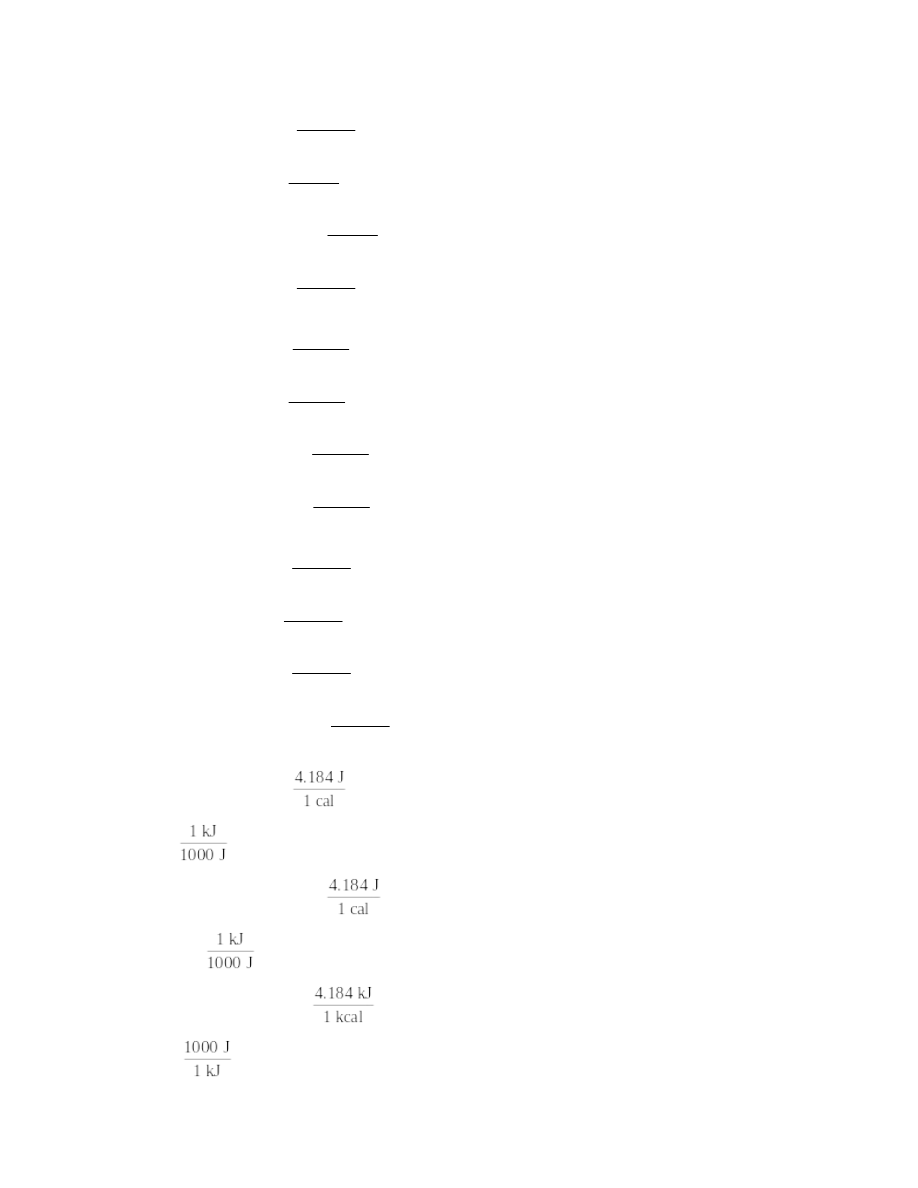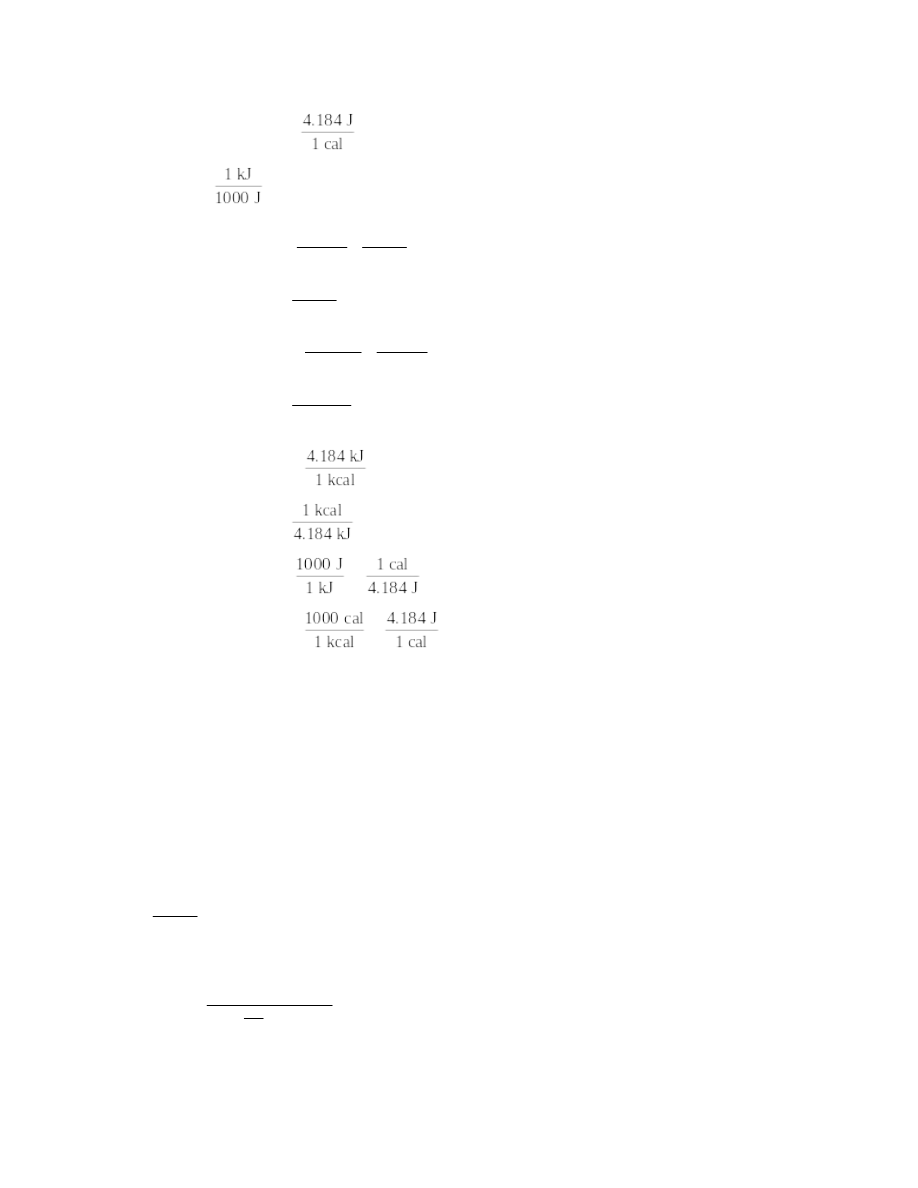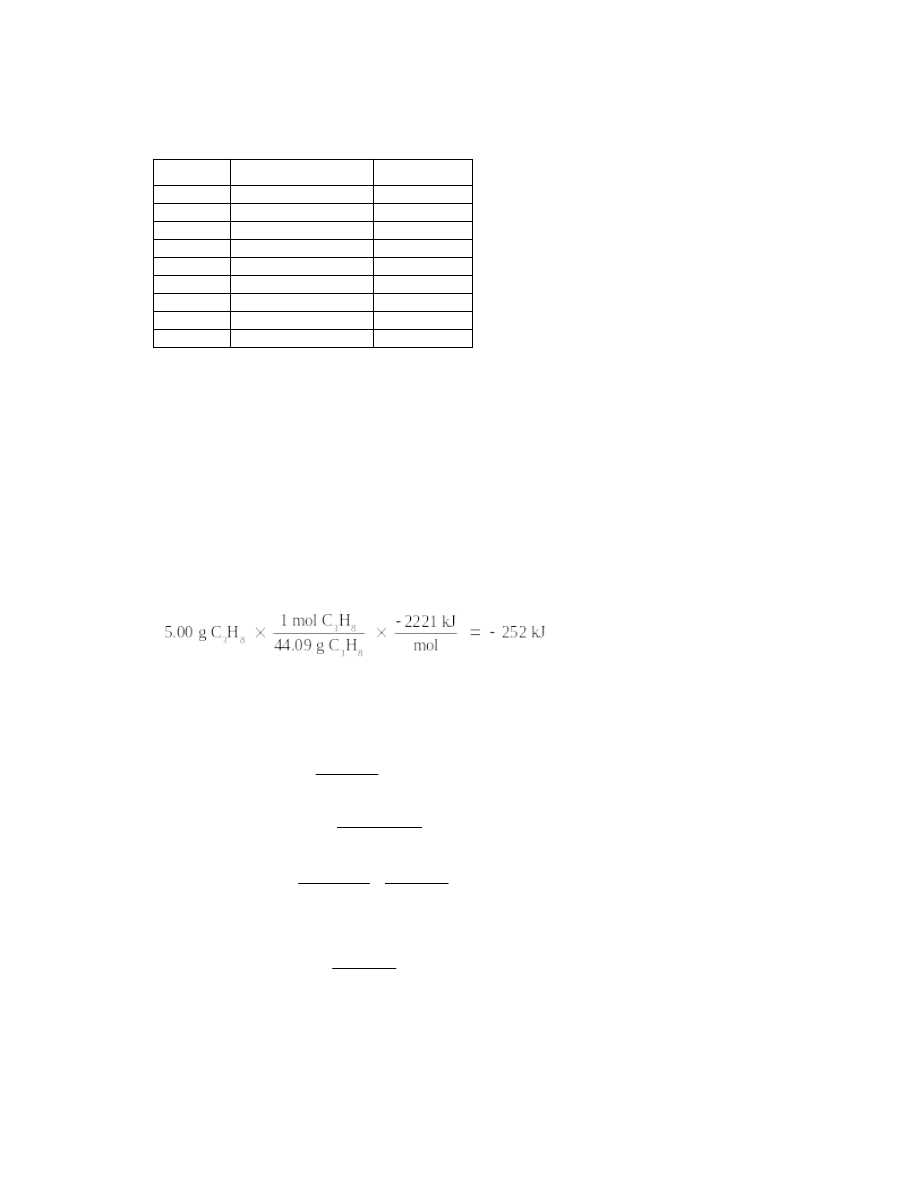
CHAPTER 10
Energy
1.
energy
2.
Potential energy is energy due to position or composition. A stone at the top of a hill possesses po
tential energy since the stone may eventually roll down the hill. A gallon of gasoline possesses po
tential energy since heat will be released when the gasoline is burned.
3.
KE =
2
1
2
mv
4.
The total energy of the universe is constant.
5.
A state function is a property of a system which changes independently of the pathway taken to m
ake the change in the system. For example, the actual vertical distance between corresponding poi
nts on the 2nd floor and on the 3rd floor in your dormitory is a property which does not change. Yo
u might walk a different distance depending on whether you take the stairs or the elevator, but the
actual distance between the floors is a fixed distance.
6.
Ball A initially possesses potential energy by virtue of its position at the top of the hill. As Ball A
rolls down the hill, its potential energy is converted to kinetic energy and frictional (heat) energy.
When Ball A reaches the bottom of the hill and hits Ball B, it transfers its kinetic energy to Ball
B. Ball A then has only the potential energy corresponding to its new position.
7.
Temperature is a measure of the random motions of the particles in a substance, that is, temperatu
re is a measure of the average kinetic energies of the particles. Heat is the energy that flows becau
se of a temperature difference.
8.
The hot tea is at a higher temperature, which means the particles in the hot tea have higher averag
e kinetic energies. When the tea spills on the skin, energy flows from the hot tea to the skin, until
the tea and skin are at the same temperature. This sudden inflow of energy causes the burn.
9.
The thermal energy of an object represents the random motions of the particles of matter which c
onstitute the object.
10.
Temperature is the concept by which we express the thermal energy contained in a sample. We c
annot measure the motions of the particles/kinetic energy in a sample of matter directly. We kno
w, however, that if two objects are at different temperatures, the one with the higher temperature
has molecules that have higher average kinetic energies than the object at the lower temperature.
11.
The system is the part of the universe upon which we want to focus attention. In a chemical
reaction, the system represents the reactants and products of the chemical reaction. The
surroundings include everything else in the universe.
12.
When the chemical system evolves energy, the energy evolved from the reacting chemicals is tran
sferred to the surroundings.
213

Chapter 10: Energy
13.
An exothermic reaction is one which releases energy: therefore the products will have a lower pot
ential energy than did the reactants.
14.
a.
Endothermic; Energy is required to dissolve the solid KBr in water.
b.
Exothermic; Energy is released in combustions reactions.
c.
Exothermic; Energy is released when concentrated sulfuric acid dissociates in water.
d.
Endothermic; Energy is required to change the water from a liquid to a gas.
15.
Thermodynamics is the study of energy and energy transfers. The first law of thermodynamics is
the same as the law of conservation of energy, which is usually worded as “the energy of the univ
erse is constant”.
16.
internal
17.
E = q + w
a.
E = 51 kJ + (–15 kJ) = 36 kJ
b.
E = 100. kJ + (–65 kJ) = 35 kJ
c.
E = –65 kJ + (–20 kJ) = –85 kJ
18.
losing
19.
positive
20.
E = q + w = –125 kJ + 104 kJ = –21 kJ
21.
The calorie represents the amount of energy required to warm one gram of water by one Celsius d
egree. The “Calorie” or “nutritional” calorie represents 1000 calories (one kilocalorie). The Joule
is the SI unit of energy and 1 calorie is equivalent to 4.184 Joules. The Joule has a specific SI defi
nition as the energy required to exert a force of 1 Newton over a distance of 1 meter, but we tend t
o use the experimental definition above in terms of heating water.
22.
a.
1 J
4.184 cal
b.
4.184 cal
1 J
c.
1 kcal
1000 cal
d.
1000 J
1 kJ
23.
3 × 8.40 kJ = 25.2 kJ for three times the increase in temperature (a temperature increase of 15° as
opposed to 5°).
24.
6540 J = 6.54 kJ for 10 times more water
214

Chapter 10: Energy
25.
a.
75.2 kcal ×
4.184 kJ
1 kcal
= 315 kJ = 3.15 × 103 J
b.
75.2 cal ×
4.184 J
1 cal
= 315 J = 0.315 kJ
c.
1.41 × 103 cal ×
4.184 J
1 cal
= 5.90 × 103 J = 5.90 kJ
d.
1.41 kcal ×
4.184 kJ
1 kcal
= 5.90 kJ = 5.90 × 103 J
26.
a.
8254 cal ×
1 kcal
1000 cal
= 8.254 kcal
b.
41.5 cal ×
1 kcal
1000 cal
= 0.0415 kcal
c.
8.231 × 103 ×
1 kcal
1000 cal
= 8.231 kcal
d.
752,900 cal ×
1 kcal
1000 cal
= 752.9 kcal
27.
a.
652.1 kJ ×
1 kcal
4.184 kJ
= 155.9 kcal
b.
1.00 kJ ×
1 kcal
4.184 kJ
= 0.239 kcal
c.
4.184 kJ ×
1 kcal
4.184 kJ
= 1.000 kcal
d.
4.351 × 103 kJ ×
1 kcal
4.184 kJ
= 1040. kcal
28.
a.
7845 cal ×
= 32820 J
32820 J ×
= 32.82 kJ
b.
4.55 × 104 cal ×
= 1.90 × 105 J
1.90 × 105 J ×
= 190. kJ
c.
62.142 kcal ×
= 260.0 kJ
260.0 kJ ×
= 2.600 × 105 J
215

Chapter 10: Energy
d.
43024 cal ×
= 1.800 × 105 J
1.800 × 105 J ×
= 180.0 kJ
29.
a.
625.2 cal ×
4.184 J
1 kJ
1 cal
1000 J
= 2.616 kJ
b.
82.41 kJ ×
1000 J
1 kJ
= 8.241 × 104 J
c.
52.61 kcal ×
1000 cal 4.184 J
1 kcal
1 cal
= 2.201 × 105 J
d.
124.2 kJ ×
1 kcal
4.184 kJ
= 29.68 kcal
30.
a.
45.62 kcal ×
= 190.9 kJ
b.
72.94 kJ ×
= 17.43 kcal
c.
2.751 kJ ×
×
= 657.5 cal
d.
5.721 kcal ×
×
= 2.394 × 104 J
31.
Q
s
m
T
69,500 J = s × (1012 g) × (11.4C)
s = 6.02 J/g C
32.
Q
s
m
T
Specific heat capacity of aluminum is 0.89 J/gC from Table 10.1.
Q = (0.89 J/gC) × (42.7 g) × (15.2C) = 5.8 × 102 J (only two significant figures are justified).
33.
Q
s
m
T
=
Q
T
s
m
Specific heat capacity of silver is 0.24 J/gC.
J
g °C
125 J
=
0.24
29.3 g
T
= 18°C (only two significant figures are justified)
34.
Q
s
m
T
216

Chapter 10: Energy
Specific heat capacity of mercury is 0.14 J/gC
100. J = (0.14 J/gC) × 25 g × T
T = 28.6C = 29C
35.
Q
s
m
T
Specific heat capacity of gold is 0.13 J/gC
Q = (0.13 J/gC) × (55.5 g) × (25C) = 180 J = 1.8 × 102 J
36.
The reaction is exothermic: the chemical reaction liberates heat energy and warms up the beverag
e.
37.
Q
s
m
T
specific heat capacity of water = 4.184 J/g°C
Let’s assume that the density of water is exactly 1.00 g/mL during the measurement.
Q = 4.184 J/g°C × 1000 g × 15°C = 6.3 × 104 J = 63 kJ (~60 kJ to one significant figure)
38.
Q
s
m
T
specific heat capacity of water = 4.184 J/g°C
Q = 4.184 J/g°C × 100.0 g × 35°C = 1.46 × 104 J (~15 kJ to two significant figures)
39.
the same as
40.
calorimeter
41.
a.
The balanced equation as written represents the formation of two moles of HF. The
enthalpy change per mole of HF will be
542 kJ
2 mol
= –271 kJ/mol
b.
The sign of the enthalpy of reaction is negative: therefore the reaction releases heat
energy and is exothermic.
c.
The conservation of energy principle requires that the heat of a reverse process be the
same in magnitude but opposite in sign. The enthalpy of reaction for the given equation is
–542 kJ. Therefore the enthalpy change of the reverse reaction will be +542 kJ.
42.
a.
molar mass of S = 32.07 g
1.00 g S ×
1 mol S
32.07 g S
= 0.0312 mol S
From the balanced chemical equation, combustion of 0.0312 mol S would produce
0.0312 mol SO2
0.0312 mol ×
296 kJ
mol
= –9.23 kJ
b.
From the balanced chemical equation, combustion of 0.0312 mol S would produce
0.0312 mol SO2
217

Chapter 10: Energy
0.501 mol ×
296 kJ
mol
= –148 kJ
c.
The enthalpy change would be the same in magnitude, but opposite in sign = +296
kJ/mol
43.
350 cal ×
= 1.5 × 103 J (to two significant figures)
44.
a.
molar mass of ethanol = 46.07 g; we will assume that 1360 has only 3 significant figures.
–
1360 kJ
1 mol
1 mol
46.07 g
= –29.5 kJ/g
b.
Since energy is released by the combustion, H is negative: H = –1360 kJ
c.
In the reaction as written, three moles of water vapor are produced when one mole of
ethanol reacts.
2
5
2
5
2
1 mol C H OH
1360 kJ
1 mol C H OH
3 mol H O
= 453 kJ/mol H2O
45.
If the second equation is reversed and then added to the first equation, the desired equation can be
generated:
X(g) + Y(g) XY(g)
H = a kJ (as given)
XZ(g) X(g) + Z(g)
H = –b kJ (the equation was reversed)
Y(g) + XZ(g) XY(g) + Z(g)
H = a + [–b] kJ or (a – b) kJ
46.
The desired equation 2C(s) + O2(g) 2CO(g) can be generated by taking twice the first equatio
n and adding it to the reverse of the second equation:
2 × [C(s) + O2(g) CO2(g)]
H = 2 × –393 kJ = –786 kJ (equation
doubled)
2CO2(g) 2CO(g) + O2(g)
H = –(–566 kJ) = +566 kJ (equation reversed)
2C(s) + O2(g) 2CO(g)
H = (–786) + (+566) = –220 kJ
47.
The desired equation S(s) + O2(g) SO2(g) can be generated by reversing the second equation a
nd dividing the equation by 2, and then adding this to the first equation:
S(s) +
3
2 O2(g) SO3(g)
H = –395.2 kJ (as given)
2SO3(g) 2SO2(g) + O2(g)
H = –(–198.2 kJ)/2 = +99 kJ
S(s) + O2(g) SO2(g)
H = (–395.2 kJ) + (+99 kJ) = –296.1 kJ
48.
The desired equation can be generated as follows:
2CO2(g) + H2O(l) C2H2(g) + 5/2O2(g)
H = –(–1300. kJ) = 1300. kJ
2 × [C(s) + O2(g) CO2(g)]
H = 2 × –394 kJ = –788 kJ
H2(g) + 1/2O2(g) H2O(l)
H = –286 kJ
218

Chapter 10: Energy
2C(s) + H2(g) C2H2(g)
H = (1300.) + (–788 kJ) + (–286 kJ) = 226 kJ
49.
The energy is converted to the energy of motion of the car, and to friction as the car’s tires interac
t with the road. Once the potential energy has been dispersed, it cannot be reused.
50.
Once everything in the universe is at the same temperature, no further thermodynamic work can b
e done. Even though the total energy of the universe will be the same, the energy will have been d
ispersed evenly making it effectively useless.
51.
Petroleum is especially useful because it is a concentrated, easy to transport and use, source of en
ergy.
52.
Concentrated sources of energy, such as petroleum, are being used so as to disperse the energy th
ey contain, making it unavailable for further use.
53.
These sources of energy originally came from living plants and animals, which used their metabol
ic processes to store energy.
54.
Petroleum consists mainly of hydrocarbons, which are molecules containing chains of carbon ato
ms with hydrogen atoms attached to the chains. The fractions are based on the number of carbon
atoms in the chains: for example, gasoline is a mixture of hydrocarbons with 5–10 carbon atoms i
n the chains, whereas asphalt is a mixture of hydrocarbons with 25 or more carbon atoms in the c
hains. Different fractions have different physical properties and uses, but all can be combusted to
produce energy. See Table 10.3
55.
Natural gas consists primarily of methane, with small amounts of ethane, propane and butane. It i
s generally found in association with petroleum deposits.
56.
Tetraethyl lead was used as an additive for gasoline to promote smoother running of engines. It is
no longer widely used because of concerns about the lead being released to the environment as th
e leaded gasoline is burned.
57.
Coal matures through four stages: lignite, sub-bituminous, bituminous, and anthracite. The four ty
pes of coal differ in the ratio of carbon to the other elements. Anthracite has the highest fraction o
f carbon in it, and when burned, releases a larger amount of heat for a given mass.
58.
The greenhouse effect is a warming effect due to the presence of gases in the atmosphere which a
bsorb infrared radiation that has reached the earth from the sun, and do not allow it to pass back i
nto space. A limited greenhouse effect is desirable because it moderates the temperature changes i
n the atmosphere that would otherwise be more drastic between daytime when the sun is shining
and nighttime. Having too high a concentration of greenhouse gases, however, will elevate the te
mperature of the earth too much, affecting climate, crops, the polar ice caps, temperature of the oc
eans, and so on. Carbon dioxide produced by combustion reactions is our greatest concern as a gr
eenhouse gas.
59.
driving force
60.
The second law of thermodynamics says that the entropy of the universe is always increasing. En
ergy spread and matter spread lead to greater entropy (greater disorder) in the universe.
61.
an increase in entropy
219

Chapter 10: Energy
62.
Formation of a solid precipitate represents a concentration of matter.
63.
Entropy is a measure of the randomness or disorder in a system. The entropy of the universe incre
ases because the natural tendency is for things to become more disordered.
64.
The molecules in liquid water are moving around freely, and are therefore more “disordered” than
when the molecules are held rigidly in a solid lattice in ice. The entropy increases during melting.
65.
the reactants; Energy is required (input) in an endothermic reaction, thus the products are at a hig
her energy state than the reactants.
66.
1.00 g CH4 ×
= 0.0623 mol CH4
0.0623 mol CH4 ×
= –55.5 kJ
67.
a.
85.21 cal ×
4.184 J
1 cal
= 356.5 J
b.
672.1 J ×
1 cal
4.184 J
= 160.6 cal
c.
8.921 kJ ×
1000 J
1 kJ
= 8921 J
d.
556.3 cal ×
4.184 J
1 cal
×
1 kJ
1000 J
= 2.328 kJ
68.
Temperature increase = 75.0 – 22.3 = 52.7°C
J
1 cal
145 g 4.184
52.7 C
= 7641.5 cal
g C
4.184 J
= 7.65 kcal
69.
Specific heat of silver = 0.24 J/gC; 1.25 kJ = 1250 J
Temperature increase = 15.2 – 12.0 = 3.2C
Q
s
m
T
1250 J = (0.24 J/gC) × (mass of silver) × (3.2C)
mass of silver = 1627 g = 1.6 × 103 g
220

Chapter 10: Energy
70.
From Table 10.1, the specific heat capacity of iron is 0.45 J/gC.
Q
s
m
T
Q = 0.45
J
g C
× 25.1 g × 17.5°C = 197.7 J = 2.0 ×102 J (two significant figures)
71.
0.13
J
g C
×
1 cal
4.184 J
= 0.031
cal
g C
72.
2.5 kg water = 2500 g
Temperature change = 55.0 – 18.5 = 36.5C
Q
s
m
T
Q = 4.184 J/gC × 2500 g × 36.5C = 3.8 × 105 J
73.
For a given mass of substance, the substance with the smallest specific heat capacity (gold, 0.13J/
g°C) will undergo the largest increase in temperature. Conversely, the substance with the largest
specific heat capacity (water, 4.184 J/g°C) will undergo the smallest increase in temperature.
74.
Let Tf represent the final temperature reached by the system.
For the hot water, heat lost = 50.0 g × 4.184 J/gC × (100. – TfC)
For the cold water, heat gained = 50.0 g × 4.184 J/gC × (Tf – 25C)
The heat lost by the hot water must equal the heat gained by the cold water; therefore
50.0 g × 4.184 J/gC × (100. – TfC) = 50.0 g × 4.184 J/gC × (Tf – 25C)
Solving this equation for Tf gives Tf = 62.5C = 63C
75.
Let Tf be the final temperature reached.
Heat gained by water = 75 g × 4.184 J/gC × (Tf – 20C)
Heat lost by iron = 25.0 g × 0.45 J/gC × (85 – TfC)
The heat lost by the iron must equal the heat gained by the water.
75 g × 4.184 J/gC × (Tf – 20C) = 25.0 g × 0.45 J/gC × (85 – TfC)
Solving for Tf gives Tf = 22.3C = 22C
76.
Q = 7.24 kJ ×
= 7240 J
221

Chapter 10: Energy
77.
For any substance,
Q
s
m
T
. The basic calculation for each of the substances is the sa
me: Heat required = 150. g (specific heat capacity) 11.2 C
Substance
Specific Heat Capacity
Heat Required
water (l)
4.184 J/g C
7.03 103 J
water (s)
2.03 J/g C
3.41 103 J
water (g)
2.0 J/g C
3.4 103 J
aluminum
0.89 J/g C
1.5 103 J
iron
0.45 J/g C
7.6 102 J
mercury
0.14 J/g C
2.4 102 J
carbon
0.71 J/g C
1.2 103 J
silver
0.24 J/g C
4.0 × 102 J
gold
0.13 J/g C
2.2 102 J
78.
q = –213 kJ (heat is released) and ΔE = –45 kJ
ΔE = q + w
–45 kJ = –213 kJ + w
w = –45 kJ + 213 kJ = +168 kJ
79.
a.
E= q + w = –47 kJ + 88 kJ = 41kJ
b.
E = 82 + 47 = 129 kJ
c.
E = 47 + 0 = 47 kJ
d.
When the surroundings deliver work to the system, w > 0. This is the case for a and b.
80.
81.
4Fe(s) + 3O2(g) 2Fe2O3(s) H = –1652 kJ;
Note that 1652 kJ of heat are released when 4 mol Fe reacts with 3 mol O2 to produce 2 mol
Fe2O3.
a.
4.00 mol Fe ×
1652 kJ
4 mol Fe
= –1652 kJ
b.
1.00 mol Fe2O3 ×
2
3
1652 kJ
2 mol Fe O
= –826 kJ
c.
1.00 g Fe ×
1 mol Fe
1652 kJ
55.85 g Fe
4 mol Fe
= –7.39 kJ
d.
10.0 g Fe = 0.179 mol Fe; 2.00 g O2 = 0.0625 mol O2; O2 is the limiting reactant.
0.0625 mol O2 ×
2
1652 kJ
3 mol O
= –34.4 kJ heat released.
222

Chapter 10: Energy
82.
Reversing the first equation and dividing by 6 we get
3
6 D
3
6 A + B
H = +403 kJ/6
or
1
2 D
1
2 A + B
H = +67.2 kJ
Dividing the second equation by 2 we get
1
2 E + F
1
2 A
H = –105.2 kJ/2 = –52.6 kJ
Dividing the third equation by 2 we get
1
2 C
1
2 E +
3
2 D
H = +64.8 kJ/2 = +32.4 kJ
Adding these equations together we get
1
2 C + F A + B + D
H = 47.0 kJ
83.
During exercise, the body generates about 5500 kJ/hr, or about 11,000 kJ in 2 hours. Assuming al
l of this heat is lost through evaporation, we can calculate the volume of the perspiration. Water h
as a heat of vaporization of 40.7 kJ/mol. So,
11,000 kJ ×
2
1 mol H O
40.7 kJ
= 270 mol H2O
270 mol H2O ×
2
2
18.02 g H O
1 mol H O
= 4900 g H2O
Assuming a density of 1 g/mL for water, 4900 g of H2O would occupy a volume of 4900 mL or
4.9 L.
84.
(c)
85.
(a) and (e); Changing from a solid to a gas requires energy. Splitting a molecule up into its
separate atoms also requires energy. Changing from a gas to a liquid or changing from a liquid to
a solid releases energy. The reaction of hydrogen and oxygen to make water is also exothermic.
86.
Q = 2.4 mol C ×
×
× 25.0C = 5.1 × 102 J
87.
Volume of water = 10.0 m × 4.0 m × 3.0 m = 120 m3
120 m3 ×
= 1.2 × 108 cm3
mass of water = 1.2 × 108 cm3 ×
= 1.2 × 108 g
Q = (1.2 × 108 g) ×
× (24.6C – 20.2C) = 2.2 × 109 J
223

Chapter 10: Energy
88.
89.
The desired equation can be generated as follows:
¼ × [2NH3(g) + 3N2O(g) 4N2(g) + 3H2O(l)] H = ¼ × (–1010 kJ) = –252.5 kJ
¾ × [N2H4(l) + H2O(l) N2O(g) + 3H2(g)]
H = ¾ × –(–317 kJ) = 237.75 kJ
× [H2(g) + ½O2(g) H2O(l)]
H =
× (–286 kJ) = –643.5 kJ
¼ × [N2H4(l) + H2O(l) 2NH3(g) + ½O2(g)]
H = ¼ × – (–143 kJ) = 35.75 kJ
N2H4(l) + O2(g) N2(g) + 2H2O(l)
H = (–252.5) + (237.75) + (–643.5) + 35.75 = –623 kJ
224